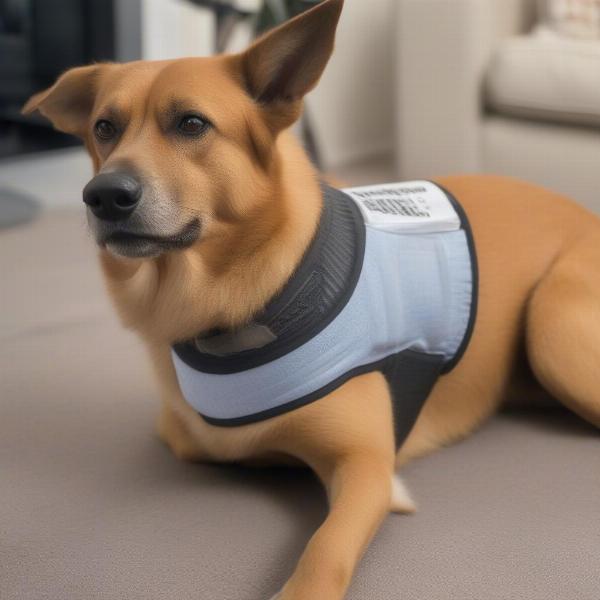Belly bands for male dogs are a helpful tool for managing urinary incontinence, marking behaviors, and even some medical conditions. Whether you’re a new dog owner or a seasoned pro, understanding how and when to use a belly band can significantly improve your dog’s comfort and your home’s cleanliness. This guide will delve into everything you need to know about belly bands, from choosing the right size to addressing potential challenges.
Understanding the Uses of Belly Bands for Male Dogs
Belly bands act as a practical solution for a range of situations. They can be a lifeline for senior dogs experiencing incontinence, offering a dignified way to manage leaks. For excitable or anxious dogs prone to marking territory inside the house, belly bands can prevent unwanted spraying. They can also be beneficial during training, especially when housebreaking a puppy or helping a rescued dog adjust to a new environment.  Belly Band for Male Dog Incontinence Furthermore, some male dogs become overly enthusiastic when greeting visitors, and a belly band can help manage any accidental “excitement dribbles.” Finally, in certain post-surgical scenarios, belly bands can protect wounds and prevent infections.
Belly Band for Male Dog Incontinence Furthermore, some male dogs become overly enthusiastic when greeting visitors, and a belly band can help manage any accidental “excitement dribbles.” Finally, in certain post-surgical scenarios, belly bands can protect wounds and prevent infections.
Choosing the Right Belly Band: Size and Material
Selecting the correct belly band is crucial for your dog’s comfort and the band’s effectiveness. Measure your dog’s waist, typically just in front of his hind legs, to determine the appropriate size. Belly bands are typically made from washable fabrics like cotton or microfiber. Consider your dog’s activity level and the climate when choosing a material. For highly active dogs, a more breathable material might be preferable.
Tips for Getting the Perfect Fit
- Snug but not tight: The belly band should fit securely without restricting movement or breathing.
- Adjustable straps: Look for belly bands with adjustable straps to ensure a customized fit.
- Multiple sizes: Many brands offer a range of sizes to accommodate different breeds and body types.
- Consider absorbency: Some belly bands have built-in absorbent pads, while others require separate pads. belly band for male dogs
Introducing Your Dog to the Belly Band
Introducing the belly band gradually and positively is key to your dog’s acceptance. Start by letting him sniff and investigate the band. Then, try placing it on him for short periods, rewarding him with praise and treats. Gradually increase the wearing time as he becomes more comfortable. Never force the belly band on him or scold him if he shows resistance. belly band male dog
Caring for Your Dog’s Belly Band and Hygiene
Regularly changing the absorbent pad or washing the belly band is essential for hygiene. Most belly bands are machine washable, but always check the manufacturer’s instructions. small female dog diapers Allow the band to air dry completely before reusing it. Inspect your dog’s skin regularly for any signs of irritation or redness. incontinence pads for male dogs
Troubleshooting Common Belly Band Issues
- Leaks: Ensure the band fits properly and the absorbent pad is positioned correctly. Consider a higher absorbency pad or changing it more frequently.
- Chafing: Check for any rough edges or seams that might be irritating your dog’s skin.
- Resistance: Make sure the band is not too tight and that your dog is comfortable wearing it. Positive reinforcement and gradual introduction are key. male wraps for dogs
Conclusion
Belly bands for male dogs offer a valuable solution for managing various challenges, from incontinence to marking behaviors. By understanding how to choose the right band, introduce it to your dog, and maintain proper hygiene, you can ensure both your dog’s comfort and a cleaner home. Remember to consult with your veterinarian if your dog’s incontinence or marking persists, as these could be signs of underlying medical issues.
FAQ
- How often should I change my dog’s belly band? Ideally, the absorbent pad should be changed every 2-4 hours, or as needed.
- Can my dog wear a belly band overnight? Yes, but ensure it fits properly and isn’t too tight.
- Are belly bands cruel? No, when used correctly, belly bands are a humane way to manage incontinence and other issues.
- Can I use human incontinence pads in my dog’s belly band? While possible, specially designed dog pads offer a better fit and absorbency.
- My dog keeps trying to take his belly band off. What should I do? Ensure a proper fit, use positive reinforcement, and consider distractions like toys or chews.
- Can belly bands be used for female dogs? While designed for males, they can sometimes be used for females with minor incontinence. However, female dog diapers are generally a better option.
- Are there alternatives to belly bands? Yes, depending on the issue, alternatives may include medications, behavioral training, or surgery.
ILM Dog is your go-to resource for expert advice and practical tips on all aspects of dog care, from breed selection and training to health, nutrition, and grooming. We strive to empower dog owners worldwide with the knowledge and resources they need to provide the best possible care for their furry companions. Whether you’re a new dog owner or a seasoned pro, ILM Dog offers a wealth of valuable information to help you navigate every stage of your dog’s life. Contact us for personalized guidance: Email: [email protected], Phone: +44 20-3965-8624. We’re here to help you and your dog thrive!